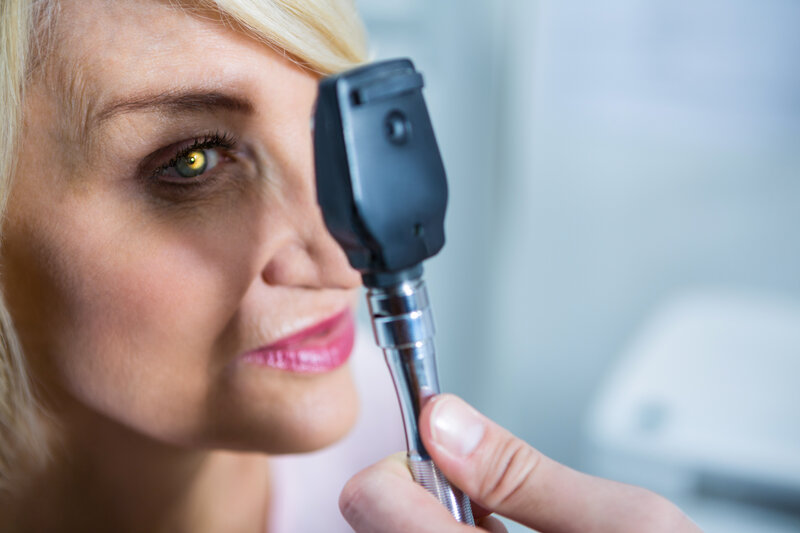What Does Eye Dilation Do?

Eye dilation helps us diagnose certain eye diseases so they can be treated as soon as possible. The conditions detected by dilating the eyes are often asymptomatic - meaning patients don’t notice any tangible or noticeable changes in their eyes until the condition is seriously progressed.
While you may not have your eyes dilated during every eye exam, your eye doctor will include it as part of a complete eye exam in certain circumstances - especially as you get older.
What To Expect When Optometrists Dilate Your Eyes
We recommend patients get a dilated eye exam every one to two years. The risk for developing certain eye conditions increases with age, so we may want to dilate your eyes every year after you turn 60 - especially if your family or personal medical history further increases any risk factors.
More frequent eye dilation during an exam typically happens when patients:
- Are 60+ years old.
- Are of African American descent.
- Have a family history of glaucoma.
We may also recommend eye dilation more often than normal if you have high blood pressure or diabetes.
Step One: Eye Dilation Eye Drops
Having your pupils dilated is painless. We use special drops that force the pupils to expand, allowing us a better and more detailed view of the interior anatomy of the eyeball. These drops don’t feel any different than the over-the-counter eye drops you use at home.
Dilating your pupils makes your eyes very light sensitive, so we dim the lights in the office and only use the light required to see into your eyes. It generally takes about 10 minutes or so for your pupils to dilate properly, after which we’ll continue the exam.
Step Two: Examining The Interior Of Your Eye
Consider your pupil like the window shades to the room of your eye. When you close the shades, less light enters the “room.”
When we dilate the pupils, they open wide, and we can get a significantly better look at the inner eye's interior contours and anatomical state - including a view of your retina and the optic nerve. This means we can look for any signs of serious eye conditions, such as:
Diabetic retinopathy
Diabetes and other health conditions affect the vascular system of the retina. If a patient experiences symptoms of diabetic retinopathy, it’s due to vascular bleeding. If significant enough, retinal vascular bleeding causes dark spots or a webbed effect in the field of vision, making it hard to read or see in detail in the distance.
Symptoms may clear up on their own if the bleeding stops, but immediate diagnosis and treatment are required to prevent diabetic retinopathy from getting worse.
Glaucoma
Glaucoma is a leading cause of vision loss and blindness and affects approximately 1 in 50 adults. It’s usually caused by increased fluid pressure inside the eye. Glaucoma has no early warning signs. Most patients do not know they have it until they visit their eye doctor. Untreated glaucoma can cause a gradual, sometimes undetectable, loss starting in your peripheral vision.
Retinal detachment
Retinal detachment, or a detached retina, means that the light-sensitive portion of your eye (the retina) has partially or fully come away from its anchor at the back of the eye. Symptoms vary according to the severity of this detachment. However, this condition can lead to permanent vision loss without early treatment.
Age-related macular degeneration
Like glaucoma, age-related macular degeneration is a leading cause of vision loss for adults 65 years and older. Age-related macular degeneration (AMD) occurs in the retina's macula area - right at the rear of the eye. It creates vision loss at the center of your gaze. So, while details will get fuzzy or disappear in the middle of your vision, you’ll still have vision on the sides (peripheral).
Sometimes Dilate The Eyes As Part Of A Treatment
Usually, we dilate the pupils to diagnose eye disease or conditions. However, sometimes, the process is used to treat eye conditions. Examples include:
Lazy eye (amblyopia)
A lazy eye occurs when the eye muscles are weak and not coordinating well with the optic nerve and brain. Sometimes, we have parents use eye drops as an alternative to patches. By dilating the pupil of the strong eye, it can’t work as well. This forces the weaker eye to get stronger. Because of the symptoms of eye dilation (more on that below), this is only used at home in the evenings or during weekends.
Inflammatory diseases
Sometimes, we prescribe pupil dilation as part of a treatment protocol for inflammatory diseases like iritis or anterior uveitis. In these cases, dilation is used along with other treatments - like steroidal eye drops- to help reduce eye inflammation and strain.
Side Effects Of Pupil Dilation: Tips & Tricks
While dilating the pupils is painless, it does cause light sensitivity and blurred vision. These symptoms usually fade within a few hours, but some people are more sensitive to the effects than others, and symptoms could last a bit longer.
For this reason, we recommend:
- Bringing a dark, full-coverage pair of sunglasses to your exam to wear afterward and minimize light sensitivity.
- Wearing a visor or broad-brimmed hat outdoors or under bright fluorescent lights.
- Having someone else drive you home from the appointment. If a friend or family member can’t do it, use a ridesharing app or taxi service to ensure you get home safely. Keep in mind that dilated pupils are a red flag for police officers, so you want to avoid being pulled over or getting involved in any traffic accidents.
- Taking the rest of the day off work.
Finally, give your eyes a break and prevent eye strain by minimizing screen use and reading for the rest of the day - or until the symptoms wear off completely.
Are You Due For A Complete Eye Exam At Eye to Eye?
Is it time to schedule your annual eye exam? Contact us here at Eye to Eye Family Vision Care. We will let you know whether or not we plan to dilate your eyes so you can plan accordingly. If you forget your sunglasses or hat, no worries! We are happy to provide you with a temporary wrap-around pair for your trip home.

